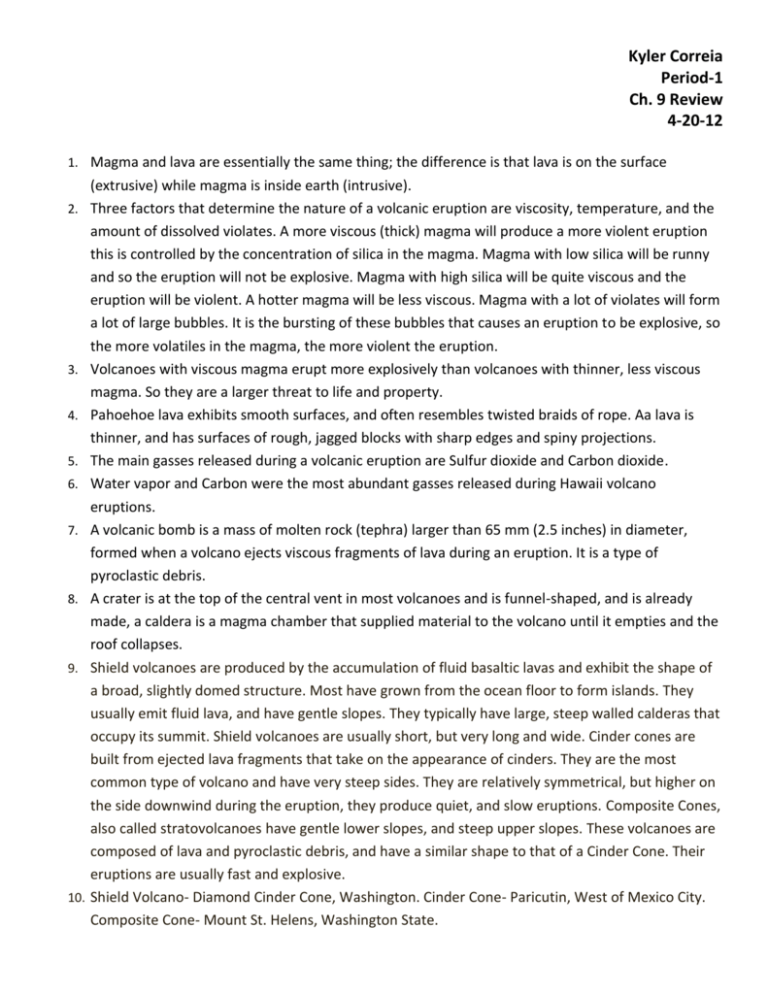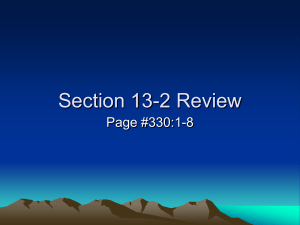Kyler Correia Period-1 Ch. 9 Review 4-20-12 - Course
advertisement

Kyler Correia Period-1 Ch. 9 Review 4-20-12 1. Magma and lava are essentially the same thing; the difference is that lava is on the surface 2. 3. 4. 5. 6. 7. 8. 9. 10. (extrusive) while magma is inside earth (intrusive). Three factors that determine the nature of a volcanic eruption are viscosity, temperature, and the amount of dissolved violates. A more viscous (thick) magma will produce a more violent eruption this is controlled by the concentration of silica in the magma. Magma with low silica will be runny and so the eruption will not be explosive. Magma with high silica will be quite viscous and the eruption will be violent. A hotter magma will be less viscous. Magma with a lot of violates will form a lot of large bubbles. It is the bursting of these bubbles that causes an eruption to be explosive, so the more volatiles in the magma, the more violent the eruption. Volcanoes with viscous magma erupt more explosively than volcanoes with thinner, less viscous magma. So they are a larger threat to life and property. Pahoehoe lava exhibits smooth surfaces, and often resembles twisted braids of rope. Aa lava is thinner, and has surfaces of rough, jagged blocks with sharp edges and spiny projections. The main gasses released during a volcanic eruption are Sulfur dioxide and Carbon dioxide. Water vapor and Carbon were the most abundant gasses released during Hawaii volcano eruptions. A volcanic bomb is a mass of molten rock (tephra) larger than 65 mm (2.5 inches) in diameter, formed when a volcano ejects viscous fragments of lava during an eruption. It is a type of pyroclastic debris. A crater is at the top of the central vent in most volcanoes and is funnel-shaped, and is already made, a caldera is a magma chamber that supplied material to the volcano until it empties and the roof collapses. Shield volcanoes are produced by the accumulation of fluid basaltic lavas and exhibit the shape of a broad, slightly domed structure. Most have grown from the ocean floor to form islands. They usually emit fluid lava, and have gentle slopes. They typically have large, steep walled calderas that occupy its summit. Shield volcanoes are usually short, but very long and wide. Cinder cones are built from ejected lava fragments that take on the appearance of cinders. They are the most common type of volcano and have very steep sides. They are relatively symmetrical, but higher on the side downwind during the eruption, they produce quiet, and slow eruptions. Composite Cones, also called stratovolcanoes have gentle lower slopes, and steep upper slopes. These volcanoes are composed of lava and pyroclastic debris, and have a similar shape to that of a Cinder Cone. Their eruptions are usually fast and explosive. Shield Volcano- Diamond Cinder Cone, Washington. Cinder Cone- Paricutin, West of Mexico City. Composite Cone- Mount St. Helens, Washington State. 11. Paricutin is a cinder cone that was formed over nine year, beginning in 1943. Cinder cones form 12. 13. 14. 15. 16. 17. 18. 19. 20. 21. from basaltic lava that is thrown into the air during the eruption, cools, then falls to form the cone shaped volcano. These form quickly and generally only erupt once. The Hawaiian volcanoes are all shield volcanoes, which form from runny basaltic lava that builds a wide volcano with gentle slopes. These are formed over a hot spot under the Pacific Plate. As the plate moves, younger volcanoes are created along the chain. These erupt for long periods of time. Crater Lake formed about 7,000 years ago when a composite cone, Mount Mazama, violently extruded more than 50 cubic kilometers of pyroclastic material. With the loss of support, nearly one mile of the summit of this cone collapsed into the area below. After the collapse, rainwater filled the caldera. The mid-ocean ridges are the longest chain of active volcanoes on earth. Ship Rock, New Mexico is an example of a volcanic neck. It formed as the outside of a volcano eroded, leaving the more weathering-resistant volcanic pipe. The eruptions that created the Colombia Plateau were fissure eruptions, lava slowly emitted by a large number of fissures covering a large area. This lava was very thin, and flowed outward. Volcanic peaks are formed around central vents, as lava pours out, it solidifies near its source, stacking up layer over layer. Sills are intrusions of igneous rocks in layers parallel to sedimentary layers. Dykes are sheets of igneous intrusions which cut across sedimentary layers. Laccoliths are similar to sills because they form when magma is intruded between sedimentary layers in a near-surface environment. However, the magma that generates laccoliths is more viscous. Batholiths are the largest intrusive igneous bodies of rock; they are large intrusions of igneous rock which replace the previous rock. Laccoliths are known to be emplaced at shallow depths. Domed strata above a laccolith may be exposed at the surface before erosion cuts down far enough to expose the igneous rock. Thus the domed strata may suggest that the top of a laccolith lies a short distance below the surface. The largest of all felsic, intrusive, igneous rock bodies are batholiths. They are massive, usually tear-drop shaped, and discordant. Thicknesses may easily exceed 10,000 feet. Magma originates when solid rock, located in the crust and upper mantle, melts Spreading centers are divergent plate boundaries. They lie above slowly rising, largely solid, mantle plumes that turn as they near the surface, carrying the diverging plates in opposite directions. Melting temperatures of rock-forming minerals increase with higher pressure and decrease with lower pressure. As the plume rises, pressures and melting temperatures are lowered but the plume loses very little of its heat; thus rock temperatures stay constant. Eventually, temperatures exceed the melting range and partial melting occurs. More melting follows as the plume rises closer to the surface. They are usually associated with basalt magma. The ring of fire is the strings and arcs of large, composite volcanoes that surround most of the Pacific Ocean. These volcanoes lie above subduction zones, where the Pacific plate is sinking beneath other oceanic plate or beneath a continental plate. 22. Very large, composite volcanoes, like those in the Ring of Fire, typically erupt explosively. The 1991 eruption of Pinatubo in the Philippines was the second most powerful eruption of the twentieth century. 23. These volcanic areas both lie above fixed hot spots, areas of partial melting deep in the mantle, below the base of the lithosphere. The hot spot track on the North Pacific plate is marked by the Hawaiian Island-Emperor Seamount chain; the track of a different hot spot beneath the North American plate is marked by the Columbia Plateau flood basalts, the Snake River Plain volcanic rocks, and the volcanic activity of the past few million years in Yellowstone National Park. The hot spots are thought to mark the tops of slowly rising mantle plumes; partial melting results from decompression escorted by heat loss. So as it rises, the plume rock remains at basically a constant temperature while its melting temperatures decrease with the lower pressures. When rocks temperatures exceed the lower limit of the melting temperature range, partial melting begin and continues as the partly-melted plume rises to even shallower depths. 24. Basalt is a dark-colored, fine-grained, igneous rock that makes up most volcanic islands in the deep ocean. 25. Volcanic eruptions are very violent and effect the immediate climate around it, smaller volcanos like Mount St Helens effected its surroundings by clogging up the atmosphere with ash, and Sulfur Dioxide which are both ejected from a volcano, a Super Volcano can cause a volcanic winter, where the Sun's light can’t penetrate through the dust and ash in the atmosphere causing, the surface temperature to go down dramatically. This would also prevent plants from performing photosynthesis which would kill the plants, and which eventually would wipe out majority of the life on earth. 1. Biosphere-There would be much more volcanic dust in the air, which may block the sun’s rays, causing plants to die and eventually wiping out all life. Also, there would be much more Sulfur Dioxide, a poisonous gas. Geosphere-There would be much more volcanic ash and debris, which would lead to the formation of many more igneous landforms. Atmosphere- There would be much more ash and debris in the air Hydrosphere- The water may be polluted with acid rain, and other things resulting from an increased amount of ash and debris. 2. Benefits of living near a volcano are: ash from an eruption is rich in chemicals and is deposited in the ground making soil very fertile. They produce spectacular scenery. They provide geothermal energy, which is extremely clean and never runs out. They also attract tourists which provide locals with more jobs. Also, Volcanoes form rare stones, so mining is carried out which also creates more local jobs.







